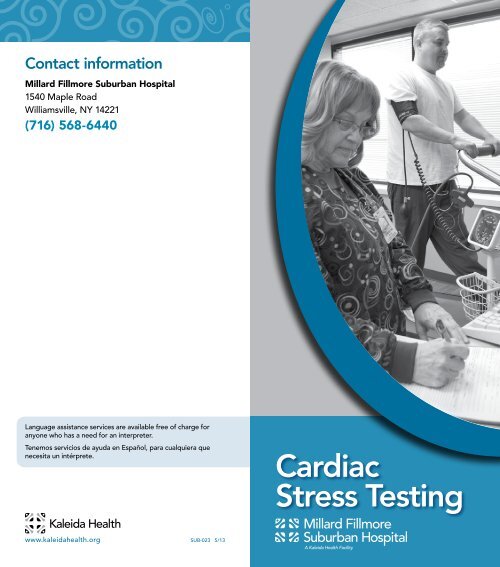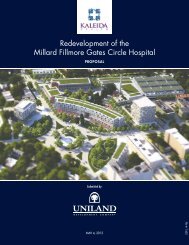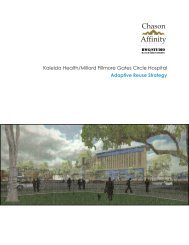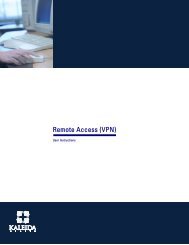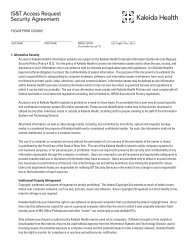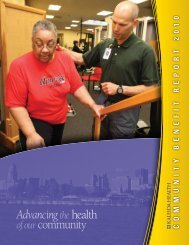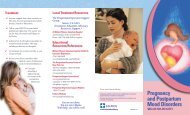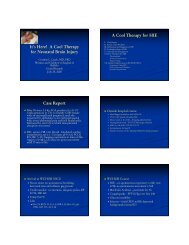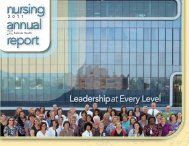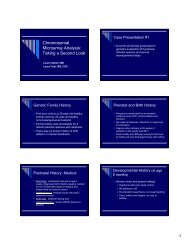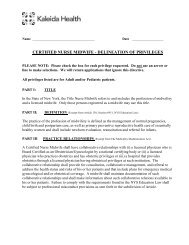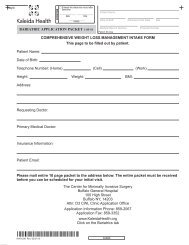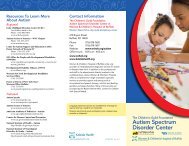Download stress testing brochure - Kaleida Health
Download stress testing brochure - Kaleida Health
Download stress testing brochure - Kaleida Health
Create successful ePaper yourself
Turn your PDF publications into a flip-book with our unique Google optimized e-Paper software.
Contact information<br />
Millard Fillmore Suburban Hospital<br />
1540 Maple Road<br />
Williamsville, NY 14221<br />
(716) 568-6440<br />
Language assistance services are available free of charge for<br />
anyone who has a need for an interpreter.<br />
Tenemos servicios de ayuda en Español, para cualquiera que<br />
necesita un intérprete.<br />
Cardiac<br />
Stress Testing<br />
www.kaleidahealth.org<br />
SUB-023 5/13
Cardiolite <strong>stress</strong> <strong>testing</strong> with nuclear imaging<br />
evaluates the possibility of coronary disease<br />
in patients. Myocardial perfusion is measured<br />
for evidence of ischemia (inadequate blood<br />
flow to the heart muscle) and/or infarct (prior<br />
heart attack), as well as cardiac function by<br />
measurement of left ventricular ejection fraction<br />
(LVEF) and wall motion.<br />
Three methods of Cardiolite<br />
<strong>stress</strong> <strong>testing</strong> are available<br />
1. The Exercise Cardiolite Stress Test is preferred.<br />
Treadmill exercise increases heart rate and<br />
systolic blood pressure (SBP) to produce<br />
greater myocardial demand for coronary blood<br />
flow (CBF) supply. Supply usually matches<br />
demand, but when demand outstrips supply,<br />
ischemia occurs and a <strong>stress</strong> defect appears<br />
that is not seen in the rest of the image.<br />
2. Persantine Cardiolite Stress Tests are used<br />
when the patient cannot exercise, has an<br />
abdominal aortic aneurysm (AAA), a left<br />
bundle branch block (LBBB) and if taking a<br />
Beta Blocker medication that blunts the heart<br />
rate response. Persantine increases CBF by<br />
allowing the natural vasodilator adenosine to<br />
accumulate. If there is a clinically significant<br />
coronary stenosis blood flow to that area,<br />
cannot increase and a relative <strong>stress</strong> defect not<br />
present in the rest image will appear.<br />
3. Dobutamine Cardiolite Stress Tests are used<br />
when the patient cannot exercise secondary<br />
to asthma or other bronchoconstrictive<br />
disease with expiratory wheezes. Dobutamine<br />
increases CBF demand by increasing heart<br />
rate. It may also increase SBP, but at higher<br />
doses, the SBP usually tends to fall and the<br />
Trendelenberg position is needed. There is<br />
greater frequency of arrhythmia. A <strong>stress</strong><br />
defect indicates that CBF demand was greater<br />
than the available supply and caused ischemia.<br />
Two methods of Echo <strong>stress</strong><br />
<strong>testing</strong> are available<br />
1. Stress Echo, with treadmill exercise, is a<br />
method to evaluate left ventricular regional<br />
wall motion (RWM) for ischemia in patients<br />
with good echo-windows. This method of<br />
cardiac <strong>stress</strong> with echo imaging is especially<br />
valuable for pregnant or nursing women, in<br />
whom you do not wish to expose the embryo<br />
or nursing infant to even a small amount<br />
of radiation or claustrophobic patients who<br />
require a cardiac <strong>stress</strong> test with imaging.<br />
2. The Dobutamine Echo Stress Test is an<br />
alternative to Cardiolite for claustrophobic<br />
patients with bronchoconstrictive disease with<br />
expiratory wheezes. Dobutamine is infused<br />
intravenously and titrated to a higher dose<br />
every three minutes to achieve a targeted heart<br />
rate. In both the exercise and Dobutamine<br />
<strong>stress</strong> echo tests, increasing CBF demand<br />
RWM will increase until demand outstrips<br />
supply and then ischemia occurs as indicated<br />
by a decrease in the RWM.


